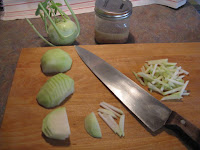 |
| Small bulbs should feel heavy in your hand |
Kohlrabi is a popular European specialty, known by many names including; German turnip, stem turnip and cabbage turnip. The above ground stem forms a bulbous growth, either round or flattened globe in shape. The thick skin is either pale green or purple. The inside flesh of both are the same off white color and there is no flavor variance. The taste and texture are similar to broccoli stem or cabbage heart but milder and sweeter with a higher ratio of flesh to skin. The fibrous outer layers are peeled away prior to cooking or serving raw. The leaves are also edible and can be used as collard greens or kale.
 |
| In the garden |
Kohlrabi is easy to grow, it is a cool season crop that likes full sun. Start seeds indoors from early spring to mid summer for a continual harvest. Planting in mid July to early August provides a fall and winter crop. Or, direct seed when the soil warms up... plant 1/4" deep, with plants spaced 4-6" apart and rows 12-18" apart. Kohlrabi is a moderate feeder and will tolerate a broad range of soil but prefers sandy loam. For a sweet, tender harvest, pick when they are about 2-3 inches in diameter. Fall crops can be picked larger and still remain tender. Kohlrabi is frost hardy in the garden. To prevent disease, practice crop rotation. Avoid planting brassicas in the same location more than once every four years. Pests include flea beetles and cabbage worms.
At the market, seek out bulbs that still have their leaves intact, it is a good indicator of freshness and that it was harvested recently. The bulb should be enclosed with skin that is firm and tight. The smaller the bulb, the sweeter the kohlrabi and it should be heavy in your hand. To store; separate the leaves from the bulb, store both in the fridge. The leaves in a sealed zip lock bag should be used with in a few days. Store the unpeeled bulbs loose for up to a few weeks.
 |
| Fermenting with dilled cukes |
Kohlrabi is tasty either raw or cooked. Always peel the bulb using a sharp knife. The fibrous outside layer does not break down when cooked and is too thick for a vegetable peeler.
It is a tasty addition to salads and is wonderful as the main ingredient in my slaw recipe below. It is crunchy, delicious and healthy when fermented in my 'E~Z Pickler', sliced in thin rounds or julienne strips. To cook, treat kohlrabi as any other root vegetable; chop and roast it until tender or add to soups and stews. To cook the greens; gently sauté the chopped stems and greens in a little olive oil and garlic.
A crunchy, juicy, crisp slaw that gets better by the second day. If you are not comfortable with knife skills to julienne the kohlrabi and apple, use a mandoline or coarsely grate.
 |
| Peel and cut in julienne strips |
3 Tbsp. apple cider vinegar
2 Tbsp. honey
2 tsp. Dijon mustard
1/4 tsp. sea salt
Freshly ground black pepper
3 Tbsp. grape seed oil
1/3 cup diced red onion
Salad:
2 kohlrabi bulbs, peeled and cut in julienne strips
1 apple, peeled, cored and cut into julienne strips
1 Tbsp. roughly chopped parsley
Place all dressing ingredients into a jar with a tight fitting lid and shake well to emulsify. Set aside for at least 10 minutes, taste and adjust seasoning. Meanwhile, peel and cut the kohlrabi and apple.
Place cut apple strips immediately in a bowl, add dressing, toss gently to thoroughly coat all the pieces. This will prevent the apple from oxidizing and turning brown. Add kohlrabi strips and parsley. Gently mix, set aside for 15 minutes.
 |
| Crunchy Kohlrabi and Apple Slaw |
Till next time... Happy Gardening and Bon Appétit!
Recipe by Sally Rae
'E~Z Pickler' by Sally Rae
Photos by Sally Rae